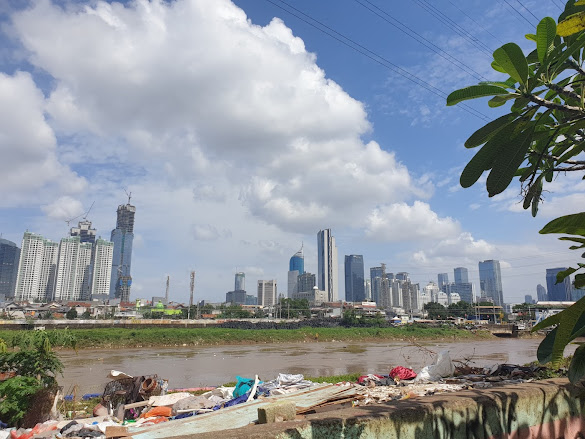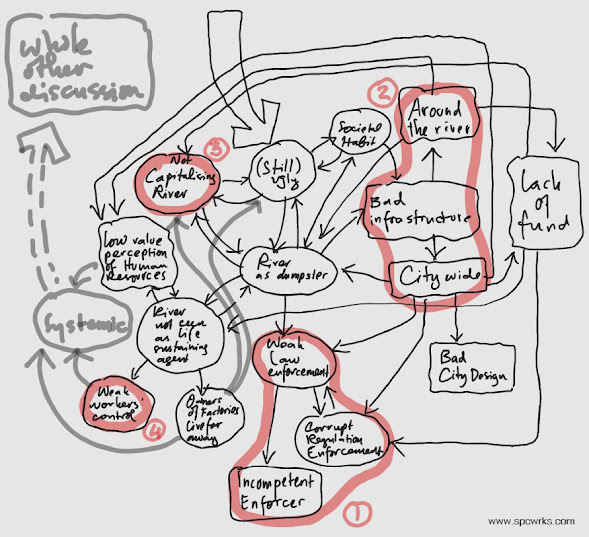Common discussions on the theme tend to be too simplistic to the level of condescending and fatalistic, it's not giving any clue to what can be done to improve the situation. In this discussion we are trying a more thorough causality exploration on why (some) public spaces in Jakarta are (still) ugly. We will take river side of Jakarta as an example.
The river is ugly because the river is treated as dumpster because the river is seen as backyard because the river is ugly, or vice versa, it brings us nowhere.
***
Instead of that, let's try a causality exploration through the Map of Why below, let's try to never stop asking why and seek the cause further.
Every arrow symbolizes a set of "why?" and "because...".
1. Society habit
It's easy to blame everything on the habit of the society because it's intangible and hard to be measured, but it gives almost zero advantage for the effort to solve the problem.
What can still be elaborated further is that every intangible aspect of a society is merely reflection of the tangible aspects in their life. The habit of society is formed by its environment and the reality that it is facing on daily basis. It's non-sensical to expect that a community that is forced to live in a slum at a river side that's being treated as a dumpster by the whole city to behave otherwise.
It is the lack of infrastructure in both river side environment and the whole city that shape the perception, behavior, habit, and in the end mindset of the people.
2. Not capitalised
To think beyond who is currently living and having activities there on the river side, the fact that the river side have not capitalised yet is also one of the reason why the river side is still ugly. There might be argumentations against this point of view but we are living in the Capitalistic realm so this is a valid reasoning for the time being.
Some might argue, why do we have to wait for some corporations to capitalise the space in order to have a good built environment, isn't it the responsibility of the government? Of course it'll be excellent when it happened, but unfortunately it's not always the case.
Capitalisation works by creating a good built environment to capture the value of a space and sell it at a much higher value. That scheme of operation actually needs a low valued underdeveloped existing space for a good margin of profit.
Why then a river side doesn't attract them? Let's avoid other societal politics like local super-landlords with their power network. Maybe because it's too ugly to be developed or because the ugly area is too widespread - creating a situation where even if a certain part of the river is capitalised and improved, the adjacent environment and the river itself are still ugly. In short, because the whole city is still treating the river as a dumpster.
3. River as dumpster
From the previous parts we can see that one of (if not the most) important factor why the river side is still ugly is because it is being treated as one giant dumpster. Why?
a. Weak law & regulation enforcement
Assuming that every organized society will create regulations to protect itself from the destruction of their living space, then it must be caused by the weak enforcement and half-hearted implementation, which in turn can be caused either by corrupt or incompetent enforcers.
But corruption and incompetence should not be the end of discussion, it's not an answer that fits all. Even without corruption, the correlation between the condition of our river side with environmental protection law and regulation and its enforcement is an enigma in itself.
We might have a complete and detailed regulation, but lack of instrument to implement it. We might have the instrument to implement, but then we don't have the resources to maintain or oversee. When we have it all, no one dares to do it when it's unpopular or internal politics of government agencies take part. Then sometimes, against common sense, there will be set back, loosening the regulation in the name of other things.
b. Rivers are not seen as life sustaining agent
The failing of law and regulation in protecting the river and creating decent river side also shows that as a society we are not putting natural protection and the decency of (some of) our public spaces as one of the important thing in our scale of priority. And in the case of rivers and river side, they are seen as many things but life sustaining agent.
In the urbanised non-agriculture society of Jakarta, where most of the waterways are drainage and not irrigation, the society automatically sees the rivers as where the water from the whole city goes: a giant sewer system.
Beyond that, the contemporary society of this city has been cut loose from the fact that historically rivers were the reason for cities to grow. It was the cities that grew around the stream of the rivers, not the other way around, as it was Sundakelapa and Jayakarta, the prototype of this city, that grew around the end stream of Ciliwung river. Instead, they now see the shape, character, and the very existence of the river as burden and problems.
But why?
Low value perception of (some) human resources
This city is fragmented spatially as much as socially. Some public spaces are more important, profitable spaces, like the roads and pedestrian path along business districts in Jakarta, therefore they are subjected to improvements. But river sides are where they who are disadvantaged economically take refugee: at one of the least taken care places in the city, the colossal dumpster.
And the sad truth is that rivers are not seen as life sustaining agent because our society sees that not all life are worth sustaining.
Weak workers control
Domestic waste is the major pollutant of the rivers in overall DKI Jakarta provincial area, but in North Jakarta, industries are the major pollutant.
Since wage-based industrial workers will get relatively the same no matter how high the profit of the industries are, it's logical that industrial workers also advocate for environmental protection other than social equality.
But we also know that since the 1965 tragedy, workers movements are not in their best shape, even completely disappeared in the most of Soeharto's 32 years New Order.
Owners of factories live far away
It's a simple fact that everyone wants to live in - other than all other things - an environmentally decent, clean, and safe place. It's also a simple fact that owners of factories generally don't live near their factories, therefore they don't take environmental protection very personally.
***
If we follow up the last three points that we've just explored and ask any further why, then the resulting answer will be in the sytemic and structural realm and there should be a whole new discussion for that. As I'm trying to keep this exploration practical and stays in the current realm, let's not move there for now.
c. Bad infrastructure
Rivers are treated as one giant dumpster because lack of infrastructure, both around the river and city-wide.
First of course the infrastructure of and around the river itself: how it flow, the river floor, flood gate, its sides, its interface with the surrounding, as well as the settlements or built environment around it.
Those infrastructures are defining the river, even giving it identity, and as we already see, creating value more than just its functional role. Bad river infrastructure avoids all the good possible things to happen around the river and invites the ugly treatment instead.
Then there are drainage infrastructures all around the city, both in public as well as private realm. As the nature of water to flow downwards, in the end the whole city are drained to the river, and through all the city-wide infrastructures, from the huge to the smallest, from the nearby to the faraway ones, are affecting the condition of the river.
An ugly river is never only about the river itself. It's also about the physical attitude of the whole city, which in turn are caused by bad city design, which should be discussed separately.
***
Of course the theme can still be explored further and deeper, but having explored the theme so far, there are several practical weak points in the web of causalities that can be assessed deeper and then addressed:
1. As an organized society with set of laws and regulations for environmental protection, including the rivers, of course the obvious point is to strengthen the whole complex of law & regulations part, including to elevate the competency of the law/regulation enforcer.
2. Changing mindset of the people is hard, what can be done is to change the material condition to allow mindset transformation. Therefore no matter how is the current condition of the river or other public space, the physical environment need to be upgraded to stop the circular chain reaction of ugliness. Refusing that, with bad people habit or unreadiness as the reason, is not only pessimistic, it's fatalistic in nature and will get us nowhere.
3. Still in tune with the second point, the city administration should promote capitalisation of the river side (while keeping it for public use). It can be done through elaborated scheme of Public Private Partnership, CSR, development regulation, FAR bonus, land use change, etc.
4. Considering the strategic position of the workers against the capital, it is also important to strengthen workers control for environmental protection; not only industrial workers, but also commercials and business workers. For environmental issues, an alliance between workers, general citizen, and students can even be formed, to give pressure to industries and businesses, property developers, as well as the government; to make sure they fulfill their obligation according to the standards, to make sure there are no breach of regulation, to make sure they do the best for environmental protection.














I'm not sure if this helps, but going back to the origins of river pollution could reveal causes related to colonialism , eg Batavia's 17th century use of Ciliwung as dumpster for the palm sugar plantations in Ommenlanded.
ReplyDeleteMuch late reply for your comment.
DeleteSince colonialism was the past reality of this place, it is interesting indeed if we can explore the relation between how the colonial society saw, perceive, and treat the river (and environment in general) with how we are now.
There might be legacy and we are not aware of it. I will explore it sometimes.
Thank you for the valuable comment!